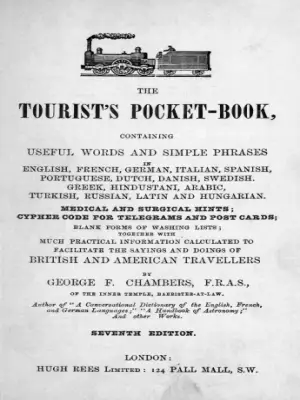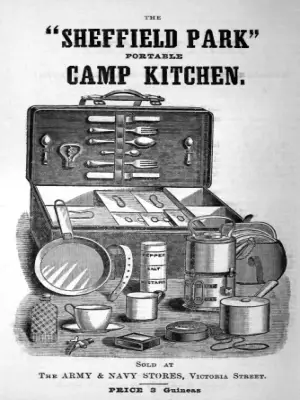Weird Old Travel Tips: From Brandy Breakfasts to Knitted Helmets!
Travel advice has come a long way over the years. While modern guides focus on packing light, staying connected, and finding the best local eats, older travel tips were… well, let’s just say they were unique. From shouting at foreigners to wearing flannel in the African heat, historical travel advice is a mix of the bizarre, the outdated, and the oddly practical. Let’s take a hilarious and informative journey through some of the strangest travel tips from the past.
1. How to Talk to “Johnny Foreigner” (Spoiler: Yell and Point)
In Chamber’s Tourist’s Pocket-Book (1904), travelers were advised to avoid forming full sentences in foreign languages. Instead, they were told to “speak slowly, use one or two words, and point boldly.” Imagine walking into a Parisian café, shouting “COFFEE! NOW!” while gesturing wildly at the menu. Charming, right?
The book even included a glossary of phrases to shout at foreigners, such as:
- “This coachman is drunk.”
- “Diarrhoea Mixture.”
- “Use plenty of starch.”
Clearly, subtlety wasn’t a priority. And if all else failed, the advice was simple: “Say only ‘Yes’ or ‘No.’” Good luck with that!

2. Don’t Eat Foreign Food (Bring Your Own Sausages)
Victorian travelers were warned against eating local cuisine, which was often dismissed as “foreign slop.” Instead, they were encouraged to bring their own food. One guide suggested packing “ham-and-chicken sausages” from London, which could last up to two weeks—unless, of course, it was “very hot weather.”
Imagine boarding a train with a suitcase full of sausages, only to discover they’ve gone bad halfway through your journey. Delightful.
3. What to Do If Your Dress Catches Fire (Lie Down Immediately)
Travel guides from the 1800s weren’t just about language and food—they also covered emergencies. For example, if a woman’s dress caught fire, the advice was clear: “Lie down on the floor immediately.” If she refused, the guide recommended “throwing her down” and keeping her in a horizontal position.
While this tip might have been practical (smothering flames by lying down), the image of someone being forcibly thrown to the ground is both alarming and oddly comical.

4. Avoid Continental Influences (They’re Bad for Morals)
Many Victorian travelers viewed foreign cultures with suspicion. William Miller’s Wintering in the Riviera (1879) warned that “Continental influences”—especially French ones—were responsible for the “laxity of tone” in English society.
Miller also criticized Germans for their “painful habit” of eating with their knives, which apparently caused “nervous dread” among English observers. One can only imagine the horror of watching someone butter their bread with the wrong utensil.
5. Surviving Africa: Flannel, Whisky, and Lion Bites
For those venturing to Africa, Bertram Francis Gurdon’s A Colony in the Making (1912) offered some… interesting advice. He listed the principal dangers as “malaria, dysentery, typhoid, sunstroke, lion bites, and whisky.”
To stay healthy, travelers were told to:
- “Take plenty of wine after sunfall” (preferably burgundy or port).
- “Keep the spirits up, the bowels open, and wear flannel next the skin.”
- “Don’t go about with fever on you. Go to bed.”
Ah, yes. Nothing says “colonial resilience” like a stiff drink and clean underwear.
6. The Importance of Flannel (and Kilts)
The Old Shekarry, a big game hunter and author of Wrinkles: Or Hints to Sportsmen and Travellers (1874), was a firm believer in the power of flannel. He recommended wearing it “next to the skin” at all times, even in the sweltering heat of Equatorial Africa.
But flannel wasn’t his only fashion tip. He also advocated for kilts, claiming they were “cooler and less liable to gall than trousers.” And for those chilly nights on safari, he suggested Chinese silk pyjamas. Because nothing says “rugged adventurer” like silk sleepwear.
7. Brandy for Breakfast (The Ultimate Travel Hack)
The Old Shekarry wasn’t just a fan of flannel and kilts—he also believed in starting the day with a hearty breakfast. His recipe for “Tiger’s Milk” included:
- Six egg yolks.
- Half a pint of rum or brandy.
- Three lumps of sugar.
- A quart of milk.
- A dash of nutmeg.
Mix it all together, and you’ve got a “stirrup cup” for three people. Because nothing says “good morning” like a brandy-infused milkshake.
8. Knitted Helmets (Because Why Not?)
Finally, no Victorian traveler would dare leave home without a knitted helmet. Yes, you read that right. These bizarre head coverings were designed to protect against sunstroke, cold weather, and—apparently—fashion faux pas.
While they might not be the most practical accessory today, they certainly add a touch of whimsy to any travel wardrobe.
Conclusion: Lessons from the Past
While some of these old travel tips are laughably outdated, others offer a fascinating glimpse into the challenges and attitudes of the past. From flannel underwear to brandy breakfasts, these guides remind us that travel has always been an adventure—albeit a slightly ridiculous one.
So, the next time you’re packing for a trip, take a moment to appreciate modern conveniences like Google Translate, sunscreen, and, well, not having to wear a knitted helmet. Safe travels!
Final Thoughts:
Historical travel advice may be quirky, but it’s a testament to how much the world has changed. Whether you’re laughing at the idea of shouting “Diarrhoea Mixture” at a stranger or cringing at outdated attitudes, these tips are a reminder to approach travel with an open mind—and maybe a little less brandy for breakfast.

